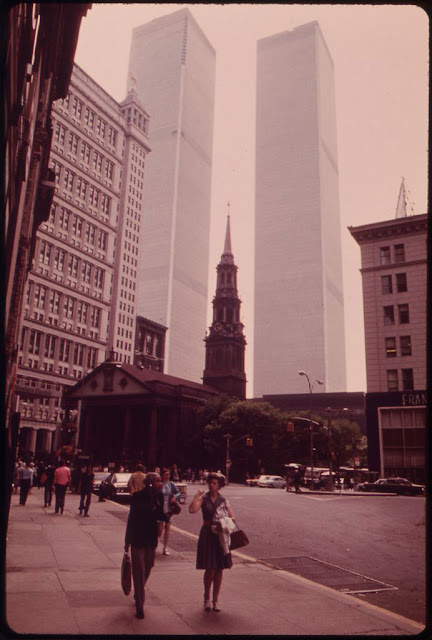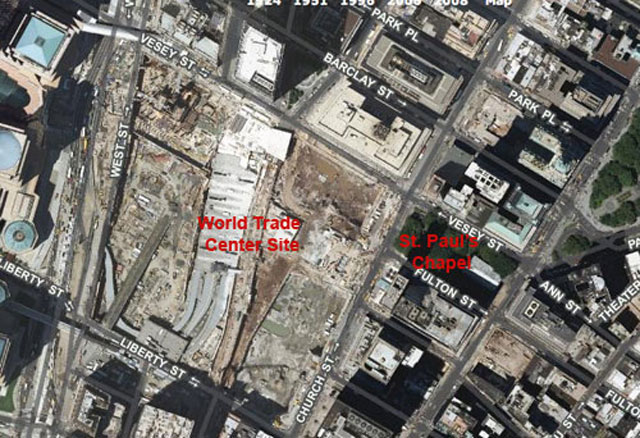The World Trade Center and St. Paul's Chapel in Downtown Manhattan
 |
| The World Trade Center right after its completion in 1973. That is St. Paul's Chapel in front of them. |
This is the story of a building. Buildings are defined as much by their surroundings as they are by their actual appearance. The Washington Monument, to take one example, is a fine obelisk, but it wouldn't have the same impact anywhere but as the centerpiece of the National Mall in Washington, D.C. St. Paul's Chapel of Trinity Church in downtown Manhattan is a fine building in its own right, but its impact is more a result of its history and the changing cityscape around it than any unique aspects of its construction. I spotted the above photo of St. Paul's Chapel from 1973 and decided to follow up to see how the same view looks now. So, this is
a comparison of St. Paul's Chapel of Trinity Church from 1973 to 2018.
 |
| The same angle view of St. Paul's Chapel from Park Row in 1831. |
St. Paul's Chapel of Trinity Church has stood in the same location for since 1766 near the intersection of Park Row and Broadway in lower Manhattan. The address is 209 Broadway. The spot was north of Wall Street, which was considered the northern boundary of the "built-up" section of New York City. St. Paul's Chapel is so old that its deed is based on land granted by Anne, Queen of Great Britain. It was the tallest building in New York City in 1766 and is considered New York's "last colonial structure." It almost burned down on September 21, 1776, during the Great Fire of New York. However, a bucket brigade of parishioners brought water over from the Hudson River (which was much nearer to the chapel than it is now) to keep St. Paul's Chapel from burning. George Washington attended services at St. Paul's Chapel regularly, including on the day of his inauguration. Nearby Trinity Church on Broadway at Wall Street burned down in the 1776 fire and has been replaced twice, but St. Paul's has stood on a lucky spot.
 |
| St. Paul's Chapel in 1907 from a slightly different angle. As can be seen, there wasn't much of note behind it to the west. |
After a few decades beginning around 1890 when the city's tallest buildings were built in midtown and downtown was somewhat overlooked, they finally returned to downtown with the construction of the World Trade Center. The 1973 picture at the top of this page marks that major turning point for the city. It also almost led to the destruction of St. Paul's Chapel.
 |
| Working in St. Paul’s churchyard following Sept 11, 2001 (FEMA). |
St. Paul's Chapel survived 9/11 even though it easily could have been destroyed. The Twin Towers were only a block away, and if the physics of the 9/11 attack been a little different, they could have fallen on it. Building No. 5 was right across the street.
A lot of debris fell on and around St. Paul's Chapel, but not enough to destroy it. It was a virtually miraculous escape. The chapel served as a relief station well into 2002. As we all know, the World Trade Center was rebuilt in a new form - but it has some eerie similarities to how it had been before.
 |
| View of Trinity Church in July 2018 (Google Street View). |
Following 9/11, the area behind St. Paul's Chapel was vacant once again, just as it had been in the 19th Century. However, nature abhors a vacuum, and the background to this view now once again is filled by the new World Trade Center building. Though a lot has changed, the background looks eerily similar once again to the one in the 1973 photograph. However, as in that photo, Trinity Church still retains its majesty despite its much larger neighbors.
I hope you enjoyed this entry in our "the more things change, the more they stay the same" series. St. Paul's Chapel of Trinity Church is the true center of gravity of lower Manhattan and the other buildings come and go around it. Please visit some of the other entries in this series to see other examples of how the city has evolved over time!
2019






No comments:
Post a Comment
Note: Only a member of this blog may post a comment.